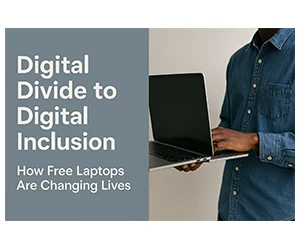Technology plays a vital role in almost every aspect of our lives - from education and employment to healthcare and community engagement. Unfortunately, not everyone has equal access to the digital tools they need. This gap, known as the digital divide, disproportionately impacts low-income communities, rural areas, and others who lack reliable internet and modern devices.
Fortunately, programs offering free laptops are making strides toward digital inclusion. By equipping individuals with essential technology, these programs open new doors, creating a more connected and equitable society.
What Exactly Is the Digital Divide?
The digital divide is the significant gap between individuals who have consistent access to digital technology (like computers and internet services) and those who don't. It's not just about owning a device—it's also about having reliable connectivity and the skills needed to fully participate online.
Several factors contribute to this divide, including:
- Economic Barriers: Low-income families may struggle to afford laptops, tablets, or monthly internet bills.
- Geographical Limitations: Rural and remote areas often lack reliable, high-speed internet.
- Lack of Digital Literacy: Even with access, some people may not have the necessary skills to effectively use technology for education, employment, or healthcare.
Without adequate digital access, individuals risk falling behind in education, job opportunities, and even essential services like healthcare.
Why Do Free Laptops Matter?
Free laptop programs directly tackle the digital divide by empowering individuals with the technology they need to thrive in key areas:
- Education: Students with laptops gain access to online classes, educational resources, interactive learning platforms, and digital libraries, greatly improving their academic performance.
- Employment Opportunities: Laptops enable job seekers to apply online, participate in virtual interviews, access career training programs, and improve their employability through online certifications.
- Healthcare Access: With a laptop, individuals can schedule medical appointments online, access telehealth services, and receive remote consultations, significantly enhancing healthcare accessibility, especially for those in rural areas.
- Community Engagement: Technology allows people to participate in local governance, access public services, and remain connected and informed within their communities.
How Free Laptop Programs Operate
Governments, nonprofits, educational institutions, and companies frequently provide free laptops to individuals who might otherwise not have digital access. These programs typically include:
- Universal Accessibility: Ensuring that everyone, regardless of financial background, has the opportunity to obtain a laptop.
- Empowerment and Independence: Providing tools that empower individuals to succeed academically, professionally, and socially.
- Community Growth: By equipping more people with digital tools, communities experience strengthened economic opportunities and increased resilience.
Addressing Ongoing Challenges
Although free laptop programs significantly reduce the digital divide, several challenges remain:
- Sustained Funding: Continuous financial support is necessary to maintain and expand these programs over time.
- Digital Literacy Training: Providing laptops alone isn’t enough; recipients often need training to effectively utilize technology.
- Reliable Internet Access: Free laptops must be paired with affordable and stable internet connections for meaningful online participation.
Creating a More Connected and Inclusive Future
Free laptop programs represent a significant step forward, but achieving true digital inclusion involves further efforts. Expanding reliable internet infrastructure, providing comprehensive digital literacy training, and ongoing support are crucial for ensuring everyone can fully participate in our increasingly digital society.
When individuals have equal digital opportunities, the entire community benefits—creating new economic growth, educational opportunities, and increased overall wellbeing. Digital inclusion doesn't just benefit individuals; it builds stronger, more vibrant, and equitable communities for all.
Conclusion - Bridging the Digital Divide Together
Access to technology isn't a luxury—it's a necessity in today's world. Free laptop initiatives are a powerful solution for reducing the digital divide and promoting digital inclusion. By investing in technology access and digital skills, we are investing in a fairer, more connected society.
Let's continue supporting and expanding these initiatives, ensuring no one is left behind in our shared digital future.
